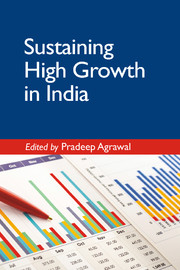Book contents
- Frontmatter
- Contents
- List of Tables
- List of Graphs and Maps
- Preface
- Introduction
- Section 1 Ensuring Macroeconomic Stability for Sustaining High Growth Rates
- Section 2 Promoting Industrial Development for Sustaining High Growth Rates
- Section 3 The International Economic Issues and Sustaining High Growth
- 6 Global Recession and the Eurozone Debt Crisis: Impact on Exports of India and China
- 7 Changing Global Trade Regime and Emergence of Mega FTAs: Strategy for India's External Sector Sustainability
- 8 Economic Impact of Foreign Capital Inflows in Emerging Asia
- 9 FDI Outflows from the BRIC Countries: Impact on Domestic Capital Formation
- Section 4 Infrastructure Bottlenecks to Sustaining High Growth
- Section 5 Some Socio-political Issues in Sustaining High Growth
- List of Contributors
- Obituary
- Index
7 - Changing Global Trade Regime and Emergence of Mega FTAs: Strategy for India's External Sector Sustainability
from Section 3 - The International Economic Issues and Sustaining High Growth
Published online by Cambridge University Press: 08 February 2018
- Frontmatter
- Contents
- List of Tables
- List of Graphs and Maps
- Preface
- Introduction
- Section 1 Ensuring Macroeconomic Stability for Sustaining High Growth Rates
- Section 2 Promoting Industrial Development for Sustaining High Growth Rates
- Section 3 The International Economic Issues and Sustaining High Growth
- 6 Global Recession and the Eurozone Debt Crisis: Impact on Exports of India and China
- 7 Changing Global Trade Regime and Emergence of Mega FTAs: Strategy for India's External Sector Sustainability
- 8 Economic Impact of Foreign Capital Inflows in Emerging Asia
- 9 FDI Outflows from the BRIC Countries: Impact on Domestic Capital Formation
- Section 4 Infrastructure Bottlenecks to Sustaining High Growth
- Section 5 Some Socio-political Issues in Sustaining High Growth
- List of Contributors
- Obituary
- Index
Summary
INTRODUCTION
The relationship between trade and economic growth remains ambiguous and inconclusive (see for instance, Baldwin, 2003; Dollar and Kraay, 2004; for two opposing sets of results and inferences), but it is common knowledge that when countries enter into an Free Trade Agreement (FTA), trade is diverted away from the non-FTA members. What is also established is that FTAs per se have a strong positive impact on the economic growth of member states (Sohn and Lee, 2010). In an era of globalization, FTAs have grown in number in the past two decades. In the backdrop of the stalled Doha development round and an ensuing question mark on the future of multilateralism, there has been a proliferation of Regional Trade Agreements (RTAs). The World Trade Organization (WTO) notifies that as of 1 July 2016, 423 RTAs were in force. In short, free trade and agreements governing free trade are far from new in an era of internationalism.
As the WTO regime continued to drift towards irrelevance with the stalled Doha round, countries started embarking upon regional and bilateral arrangements for trade liberalization. Although the trade facilitation deal has been signed after much delay and confusion, the US-inspired Trans Pacific Partnership (TPP) and Transatlantic Trade and Investment Partnership (TTIP) and the China-led Regional Comprehensive Economic Partnership (RCEP) continue to cast doubts on the future of multilateral trading systems like the WTO. India on its part has of late been engaging more and more with regional and bilateral arrangements, which allow economic integration with other countries at more favourable terms – particularly, when the negotiating parties come from comparable levels of economic development. Currently, over 25 such agreements are either operational or at various stages of negotiations by the Ministry of Commerce and Trade. Since the liberalization process began in 1991, India has integrated itself into the global economy in steps. Barriers to trade have fallen and so have limits on FDI. Tariffs have gone down from around 79 per cent to 16 per cent over the past one and a half decades, much of it between 1990 and 1997 (Gasiorek et al., 2007). Exports have been promoted by various policy measures. As a result, India's share of world trade rose in the past two decades to 2.07 per cent in 2013, up from 1.31 per cent seven years earlier.
- Type
- Chapter
- Information
- Sustaining High Growth in India , pp. 215 - 234Publisher: Cambridge University PressPrint publication year: 2017

